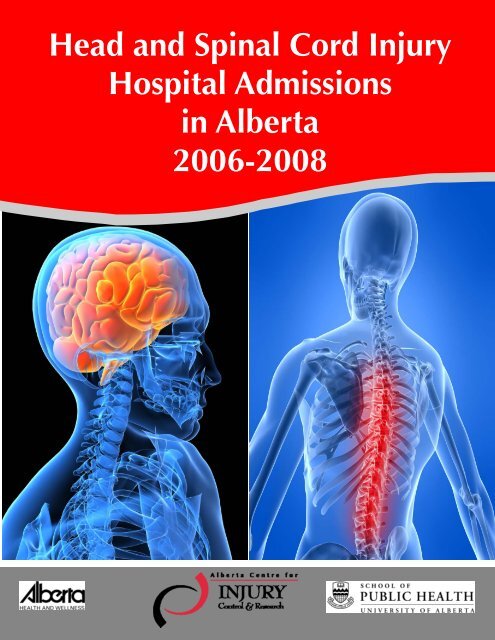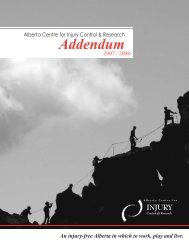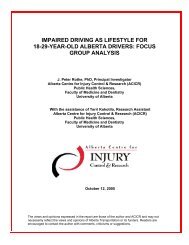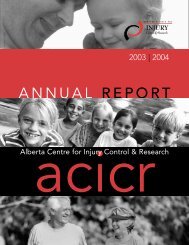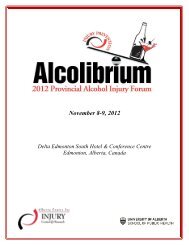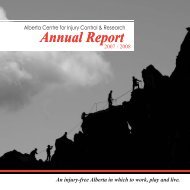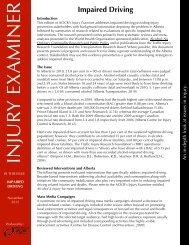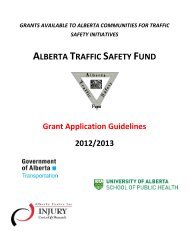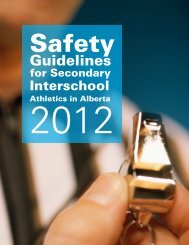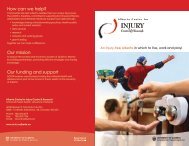Head and Spinal Cord Injuries 2006-2008 - Alberta Centre for Injury ...
Head and Spinal Cord Injuries 2006-2008 - Alberta Centre for Injury ...
Head and Spinal Cord Injuries 2006-2008 - Alberta Centre for Injury ...
Create successful ePaper yourself
Turn your PDF publications into a flip-book with our unique Google optimized e-Paper software.
<strong>Head</strong> <strong>and</strong> <strong>Spinal</strong> <strong>Cord</strong> <strong>Injury</strong><br />
Hospital Admissions<br />
in <strong>Alberta</strong><br />
<strong>2006</strong>-<strong>2008</strong>
<strong>Head</strong> <strong>Injuries</strong> – <strong>Alberta</strong>, <strong>2006</strong>-<strong>2008</strong><br />
A head injury can be the result of trauma such as a blow to the head or penetration of the skull, or it can be from disease/<br />
infection, lack of oxygen to the brain or substance abuse. The brain is the body’s control centre <strong>and</strong> any damage can cause serious<br />
problems. These may include problems with memory, behavioural or personality changes, movement disorder, paralysis,<br />
change in vision, loss of hearing, persistent headaches or seizures, anger <strong>and</strong> impulse control problems, loss of motor function,<br />
impaired speech, loss of consciousness <strong>and</strong> death. The head injury data described in this report is trauma related.<br />
• Over the 3 year period there were on average 2,227 hospital admissions each year with a traumatic head injury.<br />
• The head injury hospital admission rates remained consistent over the 3 year period.<br />
• Males had twice as many head injury hospital admissions as females.<br />
• Males accounted <strong>for</strong> 70 per cent of the admissions with an average of 1,565 admissions each year.<br />
• Falls were the leading cause of traumatic head injuries <strong>and</strong> accounted <strong>for</strong> 40 per cent of the admissions with an average of<br />
892 admissions each year.<br />
− For males, falls accounted <strong>for</strong> 35 per cent of the head injury admissions with an average of 555 admissions each<br />
year.<br />
− For females, falls accounted <strong>for</strong> 50 per cent of the head injury admissions with an average of 337 admissions each<br />
year.<br />
• Motor vehicle collisions were the second leading cause of head injury admissions <strong>and</strong> accounted <strong>for</strong> 27 per cent with an<br />
average of 602 admissions each year.<br />
− For males, motor vehicle collisions accounted <strong>for</strong> 26 per cent of the head injury admissions with an average of 425<br />
admissions each year.<br />
− For females, motor vehicle collisions accounted <strong>for</strong> 27 per cent of the head injury admissions with an average of<br />
177 admissions each year.<br />
<strong>Head</strong> <strong>Injury</strong> Hospital Admission Rate, <strong>Alberta</strong>, <strong>2006</strong>-<strong>2008</strong><br />
<strong>Alberta</strong>ns between the ages of 15 <strong>and</strong> 24 years had the highest number of admissions with an average of 448 admissions each<br />
year. Seniors older than 75 years of age had the highest hospital admission rates. Residents 75 to 84 years of age had a rate of<br />
185.725 admissions per 100,000 population <strong>and</strong> those 85 years of age <strong>and</strong> older had a rate of 300.28 admissions per 100,000<br />
population.<br />
350.00<br />
300.00<br />
250.00<br />
Rate per 100,000 population<br />
200.00<br />
150.00<br />
100.00<br />
50.00<br />
0.00<br />
<strong>Spinal</strong> <strong>Cord</strong> <strong>Injuries</strong> – <strong>Alberta</strong>, <strong>2006</strong>-<strong>2008</strong><br />
The spinal cord is a major part of the central nervous system. It acts like a telephone cable, sending messages from the brain to<br />
the body <strong>and</strong> carrying signals from the body back to the brain. The spinal cord is protected by a membrane, fluid <strong>and</strong> 33 vertebrae<br />
that make up the spinal column. This important organ, only about the width of your baby finger, is highly susceptible to<br />
damage caused by severing, compression, stretching, decreased oxygen or exposure to blood from outside the spinal column.<br />
• Over the 3 year period there were on average 146 spinal cord injury hospital admissions each year.<br />
• There has been an 15 per cent increase in cord injury hospital admission crude rates over the 3 year reporting period.<br />
• Males admitted to hospital with a spinal cord injury outnumbered females almost 4 to 1.<br />
• Males accounted <strong>for</strong> 80 per cent of the spinal cord injury admissions with an average of 117 admissions each year.<br />
• Overall, falls were the leading cause of spinal cord injury hospital admissions <strong>and</strong> accounted <strong>for</strong> 37 per cent of the admissions<br />
with an average of 53 admissions each year. There has been an 43 per cent increase in the number of fall related<br />
spinal cord injury from 46 admissions in <strong>2006</strong> to 66 admissions in <strong>2008</strong>.<br />
− For males, falls were the leading cause of spinal cord injury hospital admissions <strong>and</strong> accounted <strong>for</strong> 37 per cent of<br />
the admissions with an average of 43 admissions each year.<br />
− For females, falls were the second leading cause of spinal cord injury hospital admissions <strong>and</strong> accounted <strong>for</strong> 34 per<br />
cent of the admissions with an average of 10 admissions each year.<br />
• Overall, motor vehicle collisions were the second leading cause of spinal cord injury hospital admissions <strong>and</strong> accounted <strong>for</strong><br />
33 per cent of the admissions with an average of 48 admissions each year.<br />
− For males, motor vehicle collisions were the second leading cause of spinal cord injury hospital admissions <strong>and</strong><br />
accounted <strong>for</strong> 31 per cent with an average of 36 admissions each year.<br />
− For females, motor vehicle collisions were the leading cause of spinal cord injury hospital admissions <strong>and</strong> accounted<br />
<strong>for</strong> 41 per cent of the admissions with an average of 12 admissions each year.<br />
<strong>Spinal</strong> <strong>Cord</strong> <strong>Injury</strong> Hospital Admission Rate, <strong>Alberta</strong>, <strong>2006</strong>-<strong>2008</strong><br />
<strong>Alberta</strong>ns between 15 <strong>and</strong> 24 years of age had the highest number of spinal cord injury admissions with an average of 24 admissions<br />
each year. However, seniors between 75 <strong>and</strong> 84 years of age had the highest hospital admission rate with a rate of<br />
5.87 admissions per 100,000 population.<br />
16.00<br />
14.00<br />
12.00<br />
Rate per 100,000 population<br />
10.00<br />
8.00<br />
6.00<br />
4.00<br />
2.00<br />
0.00<br />
-2.00<br />
Other Facts 1<br />
• 50 per cent of all deaths from injury are from brain injuries<br />
• 30 per cent of all traumatic brain injuries are sustained by children <strong>and</strong> youth.<br />
• Each severe brain injury costs our medical system over $400,000 at the time of injury. Costs remain approximately the same<br />
each year following the incident due to indirect expenses <strong>and</strong> follow-up treatment.<br />
• Bike helmets can prevent up to 88 per cent of brain injuries when used properly.<br />
• It is estimated that each dollar invested in a helmet saves $30 in social costs.<br />
Costs 2<br />
In Canada, 2000-2001<br />
• <strong>Head</strong> injuries accounted <strong>for</strong> $151 million in direct costs (hospital care, physician care <strong>and</strong> drug expenses).<br />
• <strong>Spinal</strong> cord injuries accounted <strong>for</strong> $61 million in hospital care costs.<br />
1<br />
ThinkFirst Foundation of Canada. Brain <strong>Injury</strong> Fact Sheet. [cited 2010 May 25]. Available from: http://www.thinkfirst.ca/<br />
safetyinfo.aspx.<br />
2<br />
Canadian Institute <strong>for</strong> Health In<strong>for</strong>mation (CIHI), The burden of neurological diseases, disorders, <strong>and</strong> injuries in Canada, (Ottawa:<br />
CIHI, 2007). [cited <strong>2008</strong> June 25]. Available from: http://secure.cihi.ca/cihiweb/dispPage.jsp?cw_page=AR_1689_E.<br />
The <strong>Alberta</strong> <strong>Centre</strong> <strong>for</strong> <strong>Injury</strong> Control & Research (ACICR) is committed to advancing injury control in <strong>Alberta</strong> by promoting stakeholder<br />
collaboration, capacity building <strong>and</strong> evidence-based practice in the field of injury control <strong>and</strong> research.<br />
ACICR believes in a population health perspective, where strategies will enhance the health <strong>and</strong> well-being of the overall population.<br />
ACICR provides leadership, initiative, influence, coordination <strong>and</strong> support <strong>for</strong> injury-related policies, education, in<strong>for</strong>mation services,<br />
<strong>and</strong> research across the province in order that stakeholders can fulfill their m<strong>and</strong>ates of injury control.<br />
ACICR is a provincial centre within the School of Public Health at the University of <strong>Alberta</strong> <strong>and</strong> receives its core funding from <strong>Alberta</strong><br />
Health <strong>and</strong> Wellness.<br />
Should you require additional in<strong>for</strong>mation please contact:<br />
The <strong>Alberta</strong> <strong>Centre</strong> <strong>for</strong> <strong>Injury</strong> Control & Research<br />
School of Public Health<br />
University of <strong>Alberta</strong><br />
4075 RTF, 8308 – 114 Street<br />
Edmonton, <strong>Alberta</strong> T6G 2E1<br />
Phone: 780-492-6019<br />
Fax: 780-492-7154<br />
Website: www.acicr.ualberta.ca<br />
Email: acicr@ualberta.ca<br />
Suggested citation: <strong>Alberta</strong> <strong>Centre</strong> <strong>for</strong> <strong>Injury</strong> Control & Research. <strong>Head</strong> <strong>and</strong> <strong>Spinal</strong> <strong>Cord</strong> <strong>Injury</strong> Hospital Admissions, <strong>Alberta</strong>, <strong>2006</strong>-<br />
<strong>2008</strong>. Edmonton: <strong>Alberta</strong> <strong>Centre</strong> <strong>for</strong> <strong>Injury</strong> Control & Research; 2010.<br />
Source: Canadian Institute <strong>for</strong> Health In<strong>for</strong>mation, Trauma E-reports. <strong>Head</strong> <strong>and</strong> <strong>Spinal</strong> <strong>Cord</strong> <strong>Injuries</strong>-Cause of <strong>Injury</strong> by Age, Sex,<br />
Discharge Status, <strong>and</strong> Province/Territory. [accessed 2010 May 25].<br />
For ICD-10CA code includes of head <strong>and</strong> spinal cord injuries please go to the CIHI website, Trauma E-Reports Technical Notes,<br />
NTR MDS Definition of <strong>Head</strong> <strong>and</strong> <strong>Spinal</strong> <strong>Cord</strong> <strong>Injuries</strong> UID. Available from: https://eservices.cihi.ca/NTR_MDS/<br />
pub_login_ntr_mds_Tech_Meth_Notes_e.jsp?page=techNotes.


